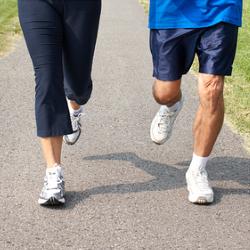Walking is a great way to burn calories and lose weight. But there are a couple of things you can do to increase the number of calories burned and to maximize your workout. Three things affect the number of calories burned when you’re looking to walk off weight.
1) Speed is Important When You Walk Off Weight
Starting out, you may be able to only walk at a pace of 3 mph giving you a pace of 20-minute miles. However by working up to a walking speed of 4.5 mph, you end up with 13-minute miles. The difference in the number of calories burned is 20 calories per mile. On a one hour walk, that is an additional 92 calories burned.
2) Distance is Needed to Walk Off Weight
It stands to reason that if you are walking faster for the same amount of time, that you will cover more distance. However if you are just starting out, work on distance before speed. The advantage of increasing your distance first is that you build endurance, i.e. you are able to sustain walking at the same pace over a longer period of time. Once you have built endurance, you can work on increasing your speed.
3) Heavier Weight Matters When You Walk Off Weight
A 120 pound person burns about 65 calories per mile walking at 3 mph on a flat surface. As a comparison, a 180 pound person walking the same distance and at the same pace burns about 95 calories. Numerically speaking, the above facts would lead you to believe that as you lose weight, you would most likely will have to increase your energy expenditure to keep burning the same number of calories. However, what can happen is that as you become fit, your basal metabolic rate increases meaning you naturally burn more calories than you did before.
Healthy Eating When you Walk Off Weight
The other half of walking off weight is to eat healthy. You can’t expect to lose weight by walking and then coming home and gorging yourself with food that is bad for you. Keep in mind that the candy bar you ate takes three to five miles of walking to burn it off! When you’re trying to walk off weight, this can be a huge handicap so be aware of this destructive habit.
A healthy diet should consists of fresh fruits and vegetables, whole grains, foods high in Omega 3 fats (such as tuna, salmon, mackerel, herring, walnuts and avocados) and lean meats.
Generally speaking a woman should eat around 1,200 to 1,300 calories per day; a man 1,500 to 1,600 per day. This should put you on a weight loss of one pound per week. If you lose more than one pound adjust your calorie intake accordingly as you may not be eating enough calories.
When you want to walk off weight and team up walking on a consistent basis along with healthy eating, you’ll be well on your way to losing weight the healthy way. Soon you’ll be enjoying life as a lighter and healthier you.
How Many Calories Do You Burn as You Walk Off Weight?
The number of calories while walking varies from person to person. You may walk the same route at the same speed with a friend who weighs about the same and is of similar age, and one of you will burn more calories than the other. Why is that?
The Other Variable as You Walk Off Weight
Besides weight, age speed and distance, the other variable is fitness level. If one of you is more fit than the other, the one that is most fit will have a higher basal metabolic rate (BMR), meaning that person naturally burns more calories at rest. While you can’t directly control your BMR, you can increase it by improving your fitness level; this is where walking comes in.
Know Your BMR
Regardless if you are walking to lose weight or improve fitness, you have to know your BMR as a starting point. An online search for “Basal Metabolic Rate Calculator” brings up a host of options. Pick one and enter your information – height, weight and age (and sedentary, if it asks for fitness level). The results are the number of calories your body needs each day to maintain your current weight at your current fitness level.
For example, a female weighing 120 pounds, 30 years old and 5 foot 4 inches tall needs to eat 1700 calories per day to maintain her current weight. To lose a pound of weight per week, she has to burn 2400 calories per day.
Calories Burned as You Walk Off Weight
So how far and fast does she have to walk to burn the additional 500 calories per day? On average, our example walking 3 mph for an hour burns 200 calories. And because speed is a factor, it makes sense that if she walked at a faster rate, she would have covered a greater distance over the same amount of time and would have burned even more calories. Having walked at 3.5 mph, would have burned an additional 50 calories.
Now before you think you are going to have to walk 2.5 hours per day, don’t forget that household chores also burn calories, so they factor into your 500 calories per day burned. For example, 30 minutes each of daily activities, such as showering, making beds, doing dishes and laundry, burn over 400 calories. Add in your hour walk and you are at 600 calories burned for the day.
Sometimes all it takes is to add in an hour of brisk walking per day – walking with a purpose – to get the extra calorie burn you need to lose weight. As you become more fit, and your basal metabolic rate increases, so will the number of calories burned at the same activity level. So strap on your walking shoes and get your “walk off weight” routine started!
If you’d like to get more out of your walking for fitness plan, check out the “Guide to Setting Your Walking Fitness Goals” for more in depth knowledge on the subject of walking for fitness. While you’re there, be sure to sign up for the free MyFitnessNut.com Newsletter to be kept up to date on the latest health and fitness topics.







